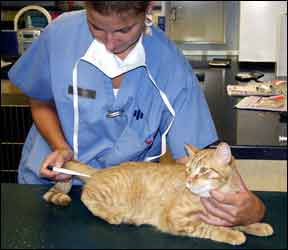You may wonder: How exactly can I take my cat’s temperature without being bitten or scratched to smithereens? Obviously, you will need to do it carefully, and if possible, with a partner. Additionally, it’s a smart idea to first have a trained staff member at your veterinary hospital demonstrate the technique for you. There may be a time when your cat is recovering from an illness and you’ll be asked by your veterinarian to monitor her temperature, so it’s a useful skill to aquire.

288
First of all, you’ll need to use a human rectal thermometer (not oral). You can choose an old style glass thermometer, or feel safer with the more modern, quick-reading electronic thermometer. If you do choose to use a glass thermometer, be sure to first shake it down to 96oF, and lubricate the tip of any type of thermometer you choose to utilize.
If your cat begins to struggle, don’t take the temperature because it will likely be inaccurate. Cats can elevate their body temperatures several degrees Fahrenheit when stressed or when they are in a very hot environment. At those times, a high temperature reading may not necessarily indicate a fever.
Getting an Accurate Reading. Experts say that you should never attempt to take an oral temperature. The thermometer can break in the cat’s mouth, causing serious injury to both the cat and you. Simply put, don’t take a temperature reading anyplace on the cat’s body other than the rectum — other readings are inaccurate.
Under normal circumstances, if you concerned that your cat is ill, you shouldn’t automatically reach for the thermometer. Reach for the telephone instead and call your veterinarian and describe your cat’s signs of illness. Carefully follow your veterinarian’s advice. Even if the cat has a fever, do not give him any medication without expert consultation first. Ibuprofen and Tylenol®, for example, can be deadly to cats.
Proper Technique. If you have a partner with you, first try to get the cat onto a steady surface, like a table. Let the cat remain standing on his four paws, or have him crouch flat. Have your partner firmly — but gently — hold the cat behind the neck. It’s okay for the cat to walk around on the tabletop while being held. Meanwhile, while petting the cat’s back, you should “walk” your hand down his body towards his tail. Now, gently grasp his tail.
The Cornell Book of Cats recommends that if you need to perform this alone, you should stand the cat on a table, and with one hand, hold the tail up and use the elbow of that arm to grip the cat’s body against you. Insert the thermometer with the other hand. While holding the base of the tail, you can gently push the thermometer into the rectum.
Although the sphincter muscles may initislly be tight, they will slowly relax enough to allow the thermometer in. Make sure that about an inch or so of the thermometer is in the rectum. Traditional thermometers should be left in the cat’s rectum for a minute or two. Digital thermometers, however, will provide a reading in ten to thirty seconds, so the convenience and swift reading may be worth considering.



